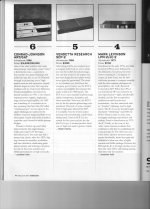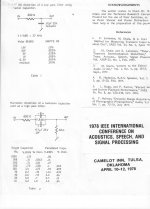I agree, this original article by Jung and Marsh showed me that I HAD to get rid of coupling caps. I worked on a preamp prototype with Enid Lumley (still have it) that I first used servos in, about 1980. Before this, I tried to use Mylar coupling caps, but they failed to be inaudible. I fought this at first, but what the heck, why not servo, now that fet input IC's were readily available? Then came the JC-80, fully servoed. Then the Lineage preamp, that unfortunately only a few prototypes were made. Finally, the Vendetta Research phono stage that took servos to their extreme. This was my '80's with servos. I have never turned back from using servos, unless the circuit can be direct coupled without anything at all being used.
John;
everything has technical explanations, without any surrealistic entities. Coupling caps between single ended BJT stages of course participate in generation of dynamic distortions changing bias points by signals so bias follows signal envelope, because such stages have non-linear and asymmetric impedances. However, one way to minimize such distortions is to use complementary, symmetrical stages. Another way is to use FETs instead of BJTs. The third way is to use DC coupled stages eliminating coupling capacitors. You choose all 3 approaches together: direct coupled, complementary, using FETs. It is not like to kill 7 ducks by a single shot. It is more like to drown a duck, then shoot it, then cut it's throat. Very reliable approach.
everything has technical explanations, without any surrealistic entities. Coupling caps between single ended BJT stages of course participate in generation of dynamic distortions changing bias points by signals so bias follows signal envelope, because such stages have non-linear and asymmetric impedances. However, one way to minimize such distortions is to use complementary, symmetrical stages. Another way is to use FETs instead of BJTs. The third way is to use DC coupled stages eliminating coupling capacitors. You choose all 3 approaches together: direct coupled, complementary, using FETs. It is not like to kill 7 ducks by a single shot. It is more like to drown a duck, then shoot it, then cut it's throat. Very reliable approach.
But, the dc servo concept I put forth to W.Jung is a better fit for this group here - just an engineering solution to some design problems.
... like the cross-over decay time correlating with loss of details etal in the region .... I think deserves more attention ... A little harder to do an ABX for that but maybe someone here could figure it out to see if it matters. Now that would be entertaining!
Wavebourn --- Has this been evaluated to death also? [I aint going thru all the pages here to find out.]
Last edited:
If somebody shoots about own results so loudly to believe that the whole world hears something does it mean it is Worldwide results?
I don't think so. To be Worldwide Results, they have to be accepted by World. We don't see it even here on our forum that does not include The World, just tiny part of it, interested in audio design.
Of course, in case of coupling of single ended BJT stages capacitors with high DA would show worse results than capacitors with low DA, because bias shift caused by their charge by asymmetric non-linear currents would be more persistent, i.e. have additional bigger time constant. But what to worry about, if your stages are symmetric, use JFETs, and far the more, are directly coupled?
I don't think so. To be Worldwide Results, they have to be accepted by World. We don't see it even here on our forum that does not include The World, just tiny part of it, interested in audio design.
Of course, in case of coupling of single ended BJT stages capacitors with high DA would show worse results than capacitors with low DA, because bias shift caused by their charge by asymmetric non-linear currents would be more persistent, i.e. have additional bigger time constant. But what to worry about, if your stages are symmetric, use JFETs, and far the more, are directly coupled?
wavebourn --- has it?Wavebourn --- Has this been evaluated to death also? [I aint going thru all the pages here to find out.]
How would you design a test for it?
Last edited:
I think that Richard would like less 'implied insults' and more real info. '-)
Yes, that is correct.
Now let me point out to everyone why I put up that page from TAS. It is in reference to criticism that I OVER-DESIGN audio components. 'Over-design' generates awards and enthusiastic feedback from happy audiophiles. A typical design might be forgotten after a year or so.
Now, it should be noted that: The Vendetta Research phono stage has NOT been produced for more than 20 years, YET it is still remembered and even given a prominent place in a lineup of the 12 most significant audio preamps ever made. Only a few hundred were produced, in fact. However, they were manufactured under my personal guidance entirely, without any third parties involved, potentially 'compromising' the design with a coupling cap, an easier to make circuit, or something else. That is the reason for its place in this line-up.
Now, it should be noted that: The Vendetta Research phono stage has NOT been produced for more than 20 years, YET it is still remembered and even given a prominent place in a lineup of the 12 most significant audio preamps ever made. Only a few hundred were produced, in fact. However, they were manufactured under my personal guidance entirely, without any third parties involved, potentially 'compromising' the design with a coupling cap, an easier to make circuit, or something else. That is the reason for its place in this line-up.
Last edited:
wavebourn --- has it?
How would you design a test for it?
Test for what? To find which factors play the role? I would design series of tests that exclude factors under suspicion, then compare result. No need to invent bicycles.
Yes, that is correct.
Me too. I believe, everyone else who participates in the discussion deserves the same, instead of silly insults like, "Bzzz... Say something smart, you fools! Release me JC from this stupid discussion! Dzzzzz".
I am out.
You design the series of tests and i'll build them and give feedback. but do it here for critical fedback all along the way. Thx, RNM
Care to add some more words to that, Mr Wurcer ?
I'll dig out a schematic.
By my bedside I keep a copy of End of Science by John Horgan.
I recommend it to everyone, the title not quite accurately describing the book.
😎
Attachments
Dick tells a story about mains noise and filtering, then says:
Scott then draws his own conclusions, as invited:
but Dick then complains that Scott has drawn the wrong conclusions:
So a story about mains and filters is not a story about mains and filters, and an invitation to draw our own conclusions must be understood to be an invitation to draw the same conclusions as the story teller.
Have I got that right?
It appeared that we were talking about shunt mains filtering, interesting enough and maybe I should have read the patents. A spin that might have been worth exploring is interference from devices that becomes "airborn" with the mains as an antenna. I would suppose that this would necessitate a filter at each emitter, but I got the distinct impression line borne interference was the subject.
I went on record 30yr. ago as being uncomfortable with the DA articles as they were presented. I told John and Walt that the residual contained no harmonic distortions only the predictable frequency response deviations (often VERY small). The general lack of curiosity and desire to go further always disturbed me. Applying large AC voltage to bring out distortions on capacitors that see little or no AC voltage in the intended application is bait (Bate?) and switch IMHO.
Fortuitous coincidence based on second hand anecdotal evidence is neither science nor engineering. There was more that one case of "I can't hear anything, but every member of the GEB I ask agrees". As I said last week OK it's fair to throw out SMT X7R's, but take 4 or 5 decent film capacitors of different chemistry and line them up in a controlled DBT by DA (measured using the standard mentioned). The claims that Teflon clearly beats PP, etc.,etc. please substantiate them.
Last edited:
X7R SMD MLCC capacitors though have their place, for digital decoupling duties their small size makes them the perfect candiate, with 100nF 0402 being probably the most placed component in the world.
X7R SMD MLCC capacitors though have their place, for digital decoupling duties their small size makes them the perfect candiate, with 100nF 0402 being probably the most placed component in the world.
Yes, the subject was AC input coupling but there are those who would still disagree with them even as bypass.

😀Yes I know, a shame as their size or lack of it makes them perfect for the job. Again the small packages available also mean they do get used for AC input coupling, where space and cost is at a premium, ie consumer goods and mobile devices. Just sticking up for these poor oft maligned devices.
Have you EVER measured the harmonic or IM distortion in an X7R cap, marce? I have:
There you are again apples and oranges. An X7R bypassing a larger cap in a power supply sees virtually NO AC voltage at audio frequencies, hence for the application at hand these measurements are not relevant. And in the second picture why not use 100uF if you want 20Hz, unless you are really pinching pennies. Now I see where Bateman got his cues, even though I know where he got his oscillator. 😉
Last edited:
- Status
- Not open for further replies.
- Home
- Member Areas
- The Lounge
- John Curl's Blowtorch preamplifier part II


